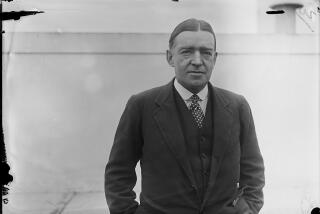Mystery Shipwreck May Rewrite History
- Share via
WARRNAMBOOL, Australia — A mysterious shipwreck that could rewrite the history books is believed to be buried in the once-shifting dunes near Warrnambool. Finding it could earn someone a load of cash. And the search wouldn’t hurt tourism, either.
The Mahogany Ship is the most famous relic of the Shipwreck Coast, which claimed more than 80 vessels and hundreds of lives in the 1800s alone. The rugged natural beauty and pounding waves that draw visitors and surfers today once were the bane of ship captains heading for Melbourne.
Theories abound on the origin of the wreck--from 13th-Century China, to 16th-Century Portugal to 17th-Century Holland. Whatever the truth, Victoria state’s tourism minister, Steve Crabb, is trying to cash in on the mystery to promote the area’s largely untapped natural wonders.
A prize of 250,000 Australian dollars ($187,000) awaits whoever finds whatever remains of the mystery ship. Crabb’s offer has drawn more than 100 nibbles in less than a month from amateur historians, adventurers, universities and salvage experts.
The wreckage of the Mahogany Ship--named for the color and hardness of its wood--was first sighted in 1836 by two seal hunters who saw a ship of unusual construction partly buried in the dunes.
Stripped of vegetation by grazing animals, the dunes constantly shifted, alternately burying and exposing the wreck about 40 times until the 1880s. Today, thriving scrub grasses have stabilized the 100-foot-high dunes and entombed the rig’s ribbing for good.
Popular legend says the ship was a Portuguese caravel that foundered in 1522 while charting Australia’s coastline. If true, some historical revision would be in order: The first recorded landing by Europeans was in 1606--64 years later--and serious European exploration of the continent did not occur until the 1790s.
Lore among the local Aboriginals, Australia’s indigenous people, includes tales of a “tribe of yellow men” who appeared on their shores. That has raised speculation that the wreck may have been part of a 13th-Century Chinese fleet sent by Emperor Cheng Ho to capture Ceylon, now Sri Lanka, just south of India.
If true, the Chinese would have reached “Down Under” some time in the same century that the overland expedition of Italy’s Marco Polo reached the ancient Chinese capital of Cathay--and nearly 200 years before Columbus arrived in the Western Hemisphere.
Others believe the Mahogany Ship is really the Dutch ship Ridderschap Van Hollant, which failed to return from southern Africa in the 1600s.
But skeptics say the wreck more likely is just one of the dozens of whaling ships that plied the area’s treacherous waters.
“The only limit on the number of theories is your imagination,” said Peter Ronald, secretary of a local group established to investigate the wreck.
An enticing story creates circumstantial evidence to back up the Portuguese theory.
A map of a land called Java La Grande is believed to show Australia’s east coast and generally is accepted as being a French copy of the Portuguese original.
K. G. McIntyre, in the book “Secret Discovery of Australia,” argues that Portuguese mariner Cristavao de Mendonca made the map during a voyage in 1522, 30 years after Columbus’ New World voyage.
If the map indeed depicts Australia, it ends near Warrnambool, and McIntyre speculates that De Mendonca halted the expedition after losing a ship there.
But despite the booty for finding the wreckage, some people feel it’s better to leave things alone.
“I sincerely hope they do not find it,” said Jack Loney, a maritime historian. “If they ever turned up something, it would mean an end to all the mystery. An end to all the stories.”
More to Read
Sign up for The Wild
We’ll help you find the best places to hike, bike and run, as well as the perfect silent spots for meditation and yoga.
You may occasionally receive promotional content from the Los Angeles Times.






